International Marketing Plan for Lion Pty Ltd: South African Market
VerifiedAdded on 2020/04/07
|15
|3066
|34
Report
AI Summary
This report presents a comprehensive global marketing plan for Lion Pty Ltd, focusing on its potential expansion into the South African market. The analysis begins with an introduction to Lion Pty Ltd and its current market position, followed by a summary of the assignment's objectives. The report then delves into the market selection process, outlining the stages involved and the reasons for choosing South Africa as the target market. It further explores alternative market entry options, including direct exporting, licensing, and joint ventures, along with positioning and target market selection strategies. The report also discusses positioning strategies and alternative generic strategies to gain a competitive advantage in the South African beverage industry. The conclusion provides recommendations based on the analysis, offering insights into the most effective approaches for Lion Pty Ltd's international expansion. This report is a valuable resource for students studying marketing and international business, providing a detailed case study and practical application of marketing principles. It highlights the importance of market research, strategic planning, and adaptation to achieve success in the global market. The report also discusses the SMART objectives of the company and how it can achieve its goals.

Running Head: Global Marketing
Lion Pty Ltd.
Global Marketing
Lion Pty Ltd.
Global Marketing
Paraphrase This Document
Need a fresh take? Get an instant paraphrase of this document with our AI Paraphraser
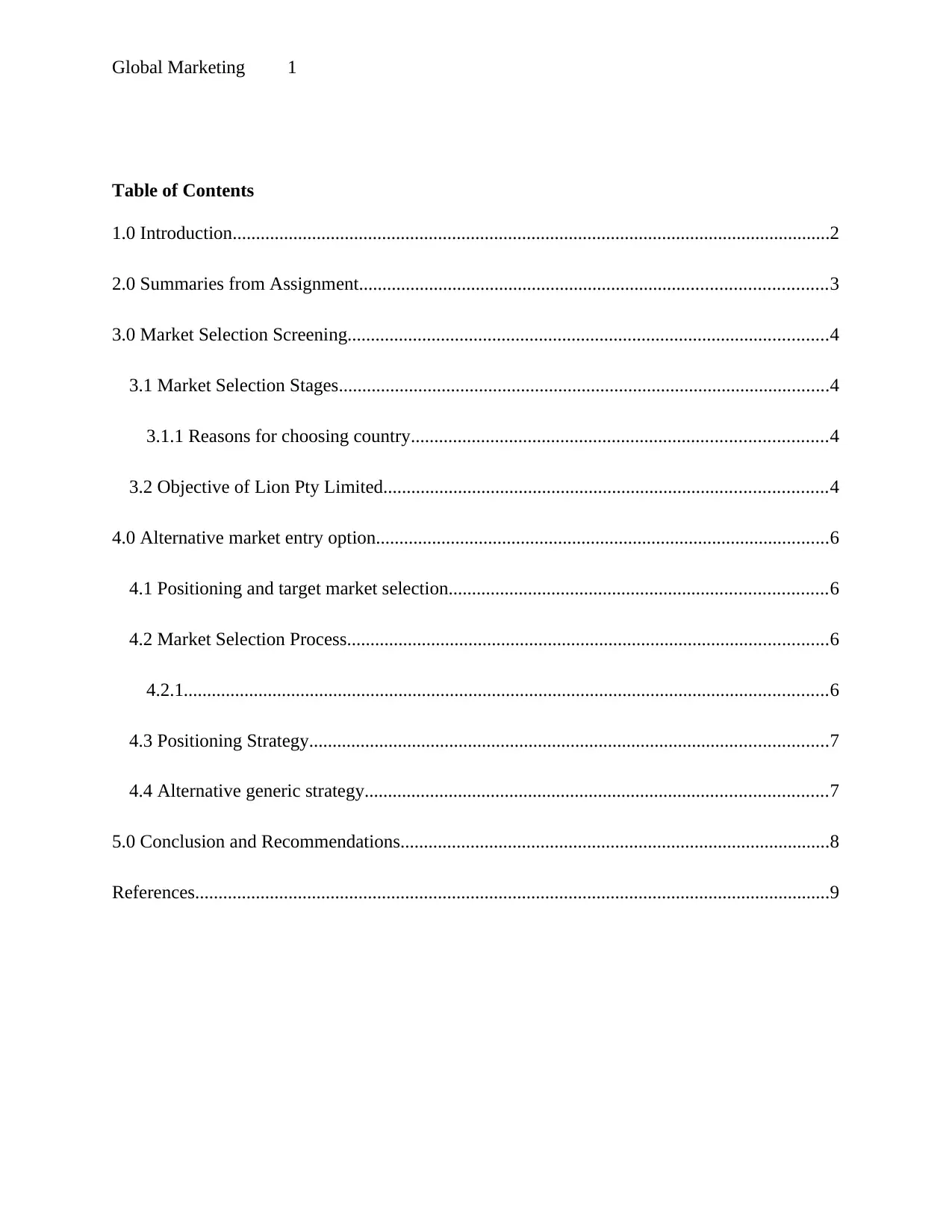
Global Marketing 1
Table of Contents
1.0 Introduction................................................................................................................................2
2.0 Summaries from Assignment....................................................................................................3
3.0 Market Selection Screening.......................................................................................................4
3.1 Market Selection Stages.........................................................................................................4
3.1.1 Reasons for choosing country.........................................................................................4
3.2 Objective of Lion Pty Limited...............................................................................................4
4.0 Alternative market entry option.................................................................................................6
4.1 Positioning and target market selection.................................................................................6
4.2 Market Selection Process.......................................................................................................6
4.2.1..........................................................................................................................................6
4.3 Positioning Strategy...............................................................................................................7
4.4 Alternative generic strategy...................................................................................................7
5.0 Conclusion and Recommendations............................................................................................8
References........................................................................................................................................9
Table of Contents
1.0 Introduction................................................................................................................................2
2.0 Summaries from Assignment....................................................................................................3
3.0 Market Selection Screening.......................................................................................................4
3.1 Market Selection Stages.........................................................................................................4
3.1.1 Reasons for choosing country.........................................................................................4
3.2 Objective of Lion Pty Limited...............................................................................................4
4.0 Alternative market entry option.................................................................................................6
4.1 Positioning and target market selection.................................................................................6
4.2 Market Selection Process.......................................................................................................6
4.2.1..........................................................................................................................................6
4.3 Positioning Strategy...............................................................................................................7
4.4 Alternative generic strategy...................................................................................................7
5.0 Conclusion and Recommendations............................................................................................8
References........................................................................................................................................9
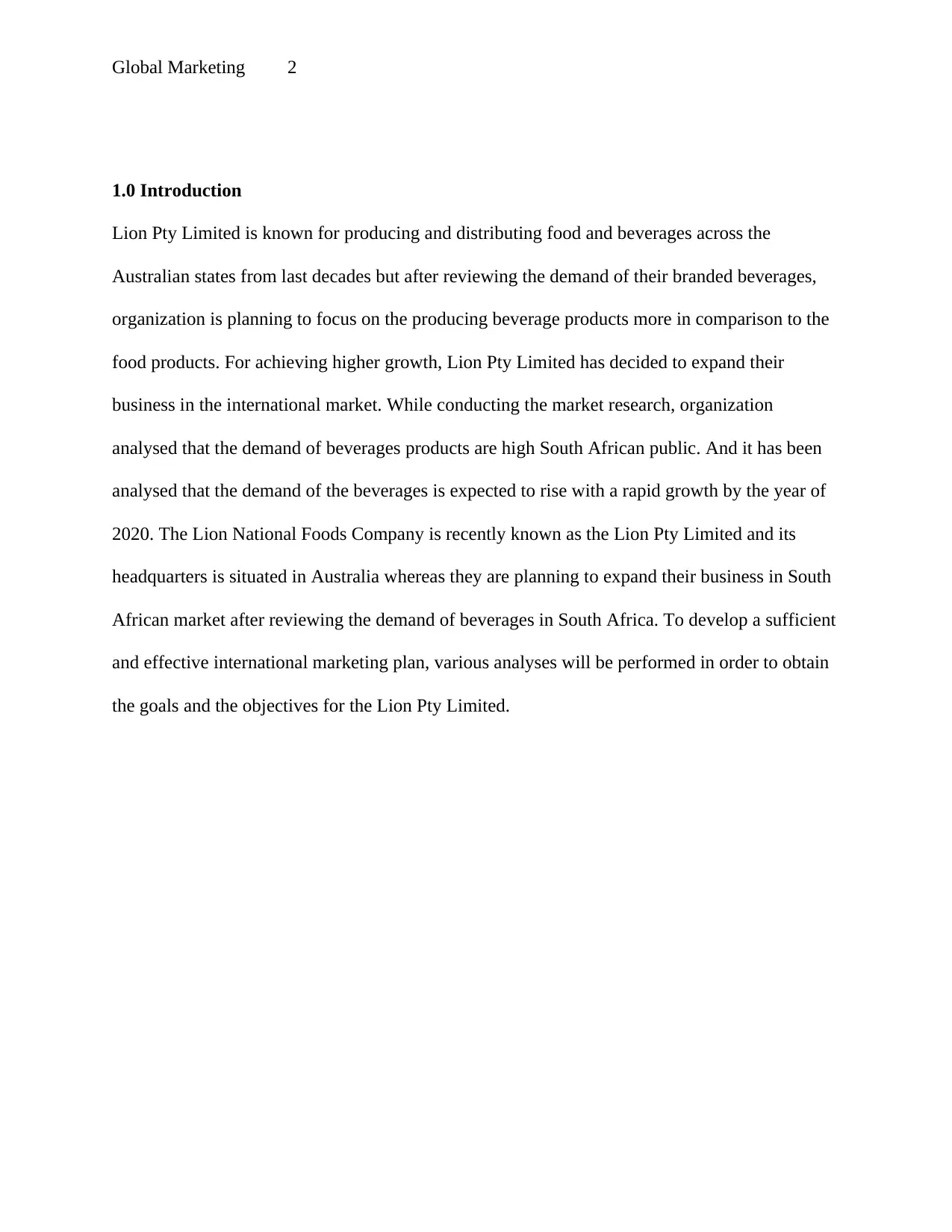
Global Marketing 2
1.0 Introduction
Lion Pty Limited is known for producing and distributing food and beverages across the
Australian states from last decades but after reviewing the demand of their branded beverages,
organization is planning to focus on the producing beverage products more in comparison to the
food products. For achieving higher growth, Lion Pty Limited has decided to expand their
business in the international market. While conducting the market research, organization
analysed that the demand of beverages products are high South African public. And it has been
analysed that the demand of the beverages is expected to rise with a rapid growth by the year of
2020. The Lion National Foods Company is recently known as the Lion Pty Limited and its
headquarters is situated in Australia whereas they are planning to expand their business in South
African market after reviewing the demand of beverages in South Africa. To develop a sufficient
and effective international marketing plan, various analyses will be performed in order to obtain
the goals and the objectives for the Lion Pty Limited.
1.0 Introduction
Lion Pty Limited is known for producing and distributing food and beverages across the
Australian states from last decades but after reviewing the demand of their branded beverages,
organization is planning to focus on the producing beverage products more in comparison to the
food products. For achieving higher growth, Lion Pty Limited has decided to expand their
business in the international market. While conducting the market research, organization
analysed that the demand of beverages products are high South African public. And it has been
analysed that the demand of the beverages is expected to rise with a rapid growth by the year of
2020. The Lion National Foods Company is recently known as the Lion Pty Limited and its
headquarters is situated in Australia whereas they are planning to expand their business in South
African market after reviewing the demand of beverages in South Africa. To develop a sufficient
and effective international marketing plan, various analyses will be performed in order to obtain
the goals and the objectives for the Lion Pty Limited.
⊘ This is a preview!⊘
Do you want full access?
Subscribe today to unlock all pages.

Trusted by 1+ million students worldwide

Global Marketing 3
2.0 Summaries from Assignment
As per the part one of this international marketing plan, Lion Pty Limited in involved in the
production and distribution of branded food and beverages products. For emerging companies,
beverage industry has always been a great choice. In South Africa, there is an area called Sub-
Saharan Africa. It is an area whose beverage consumption is quite high in relevance with the
other parts of the world. Reviewing these factors, many Australian countries have shown their
interest in expanding their beverages business in Saharan Africa. Most of the soft-drinks
companies have invested huge amounts in the sub Saharan African market by expecting the huge
market growth over there. After determining these factors, Lion Pty Limited can take the
advantage for this market growth and can utilise their available resources in order to expand their
business in South African markets. Prior to this, Lion Pty Limited is present in Australia and in
New Zealand and they have more than 6700 employees across these two countries. The chances
for Lion Pty Limited in achieving the adequate growth and the objectives are high enough
because they have acquired a great position in the Australian states and in New Zealand states as
well and in a short period of time. Reviewing this, it has been assumed that the chances of
growth and enhancing profitability are quite high in South African market using the available
resources (Akaka, Vargo & Lusch, 2013).
2.0 Summaries from Assignment
As per the part one of this international marketing plan, Lion Pty Limited in involved in the
production and distribution of branded food and beverages products. For emerging companies,
beverage industry has always been a great choice. In South Africa, there is an area called Sub-
Saharan Africa. It is an area whose beverage consumption is quite high in relevance with the
other parts of the world. Reviewing these factors, many Australian countries have shown their
interest in expanding their beverages business in Saharan Africa. Most of the soft-drinks
companies have invested huge amounts in the sub Saharan African market by expecting the huge
market growth over there. After determining these factors, Lion Pty Limited can take the
advantage for this market growth and can utilise their available resources in order to expand their
business in South African markets. Prior to this, Lion Pty Limited is present in Australia and in
New Zealand and they have more than 6700 employees across these two countries. The chances
for Lion Pty Limited in achieving the adequate growth and the objectives are high enough
because they have acquired a great position in the Australian states and in New Zealand states as
well and in a short period of time. Reviewing this, it has been assumed that the chances of
growth and enhancing profitability are quite high in South African market using the available
resources (Akaka, Vargo & Lusch, 2013).
Paraphrase This Document
Need a fresh take? Get an instant paraphrase of this document with our AI Paraphraser
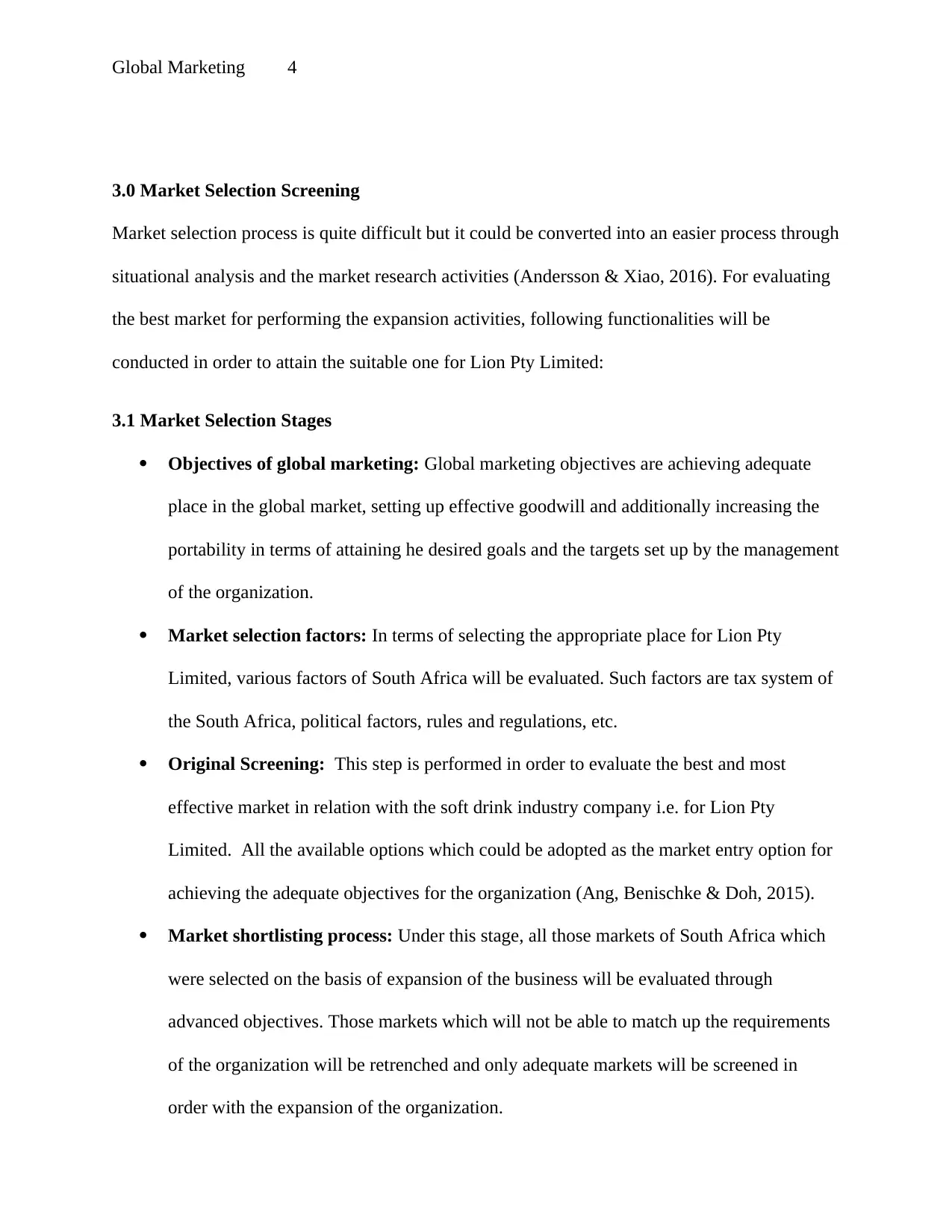
Global Marketing 4
3.0 Market Selection Screening
Market selection process is quite difficult but it could be converted into an easier process through
situational analysis and the market research activities (Andersson & Xiao, 2016). For evaluating
the best market for performing the expansion activities, following functionalities will be
conducted in order to attain the suitable one for Lion Pty Limited:
3.1 Market Selection Stages
Objectives of global marketing: Global marketing objectives are achieving adequate
place in the global market, setting up effective goodwill and additionally increasing the
portability in terms of attaining he desired goals and the targets set up by the management
of the organization.
Market selection factors: In terms of selecting the appropriate place for Lion Pty
Limited, various factors of South Africa will be evaluated. Such factors are tax system of
the South Africa, political factors, rules and regulations, etc.
Original Screening: This step is performed in order to evaluate the best and most
effective market in relation with the soft drink industry company i.e. for Lion Pty
Limited. All the available options which could be adopted as the market entry option for
achieving the adequate objectives for the organization (Ang, Benischke & Doh, 2015).
Market shortlisting process: Under this stage, all those markets of South Africa which
were selected on the basis of expansion of the business will be evaluated through
advanced objectives. Those markets which will not be able to match up the requirements
of the organization will be retrenched and only adequate markets will be screened in
order with the expansion of the organization.
3.0 Market Selection Screening
Market selection process is quite difficult but it could be converted into an easier process through
situational analysis and the market research activities (Andersson & Xiao, 2016). For evaluating
the best market for performing the expansion activities, following functionalities will be
conducted in order to attain the suitable one for Lion Pty Limited:
3.1 Market Selection Stages
Objectives of global marketing: Global marketing objectives are achieving adequate
place in the global market, setting up effective goodwill and additionally increasing the
portability in terms of attaining he desired goals and the targets set up by the management
of the organization.
Market selection factors: In terms of selecting the appropriate place for Lion Pty
Limited, various factors of South Africa will be evaluated. Such factors are tax system of
the South Africa, political factors, rules and regulations, etc.
Original Screening: This step is performed in order to evaluate the best and most
effective market in relation with the soft drink industry company i.e. for Lion Pty
Limited. All the available options which could be adopted as the market entry option for
achieving the adequate objectives for the organization (Ang, Benischke & Doh, 2015).
Market shortlisting process: Under this stage, all those markets of South Africa which
were selected on the basis of expansion of the business will be evaluated through
advanced objectives. Those markets which will not be able to match up the requirements
of the organization will be retrenched and only adequate markets will be screened in
order with the expansion of the organization.
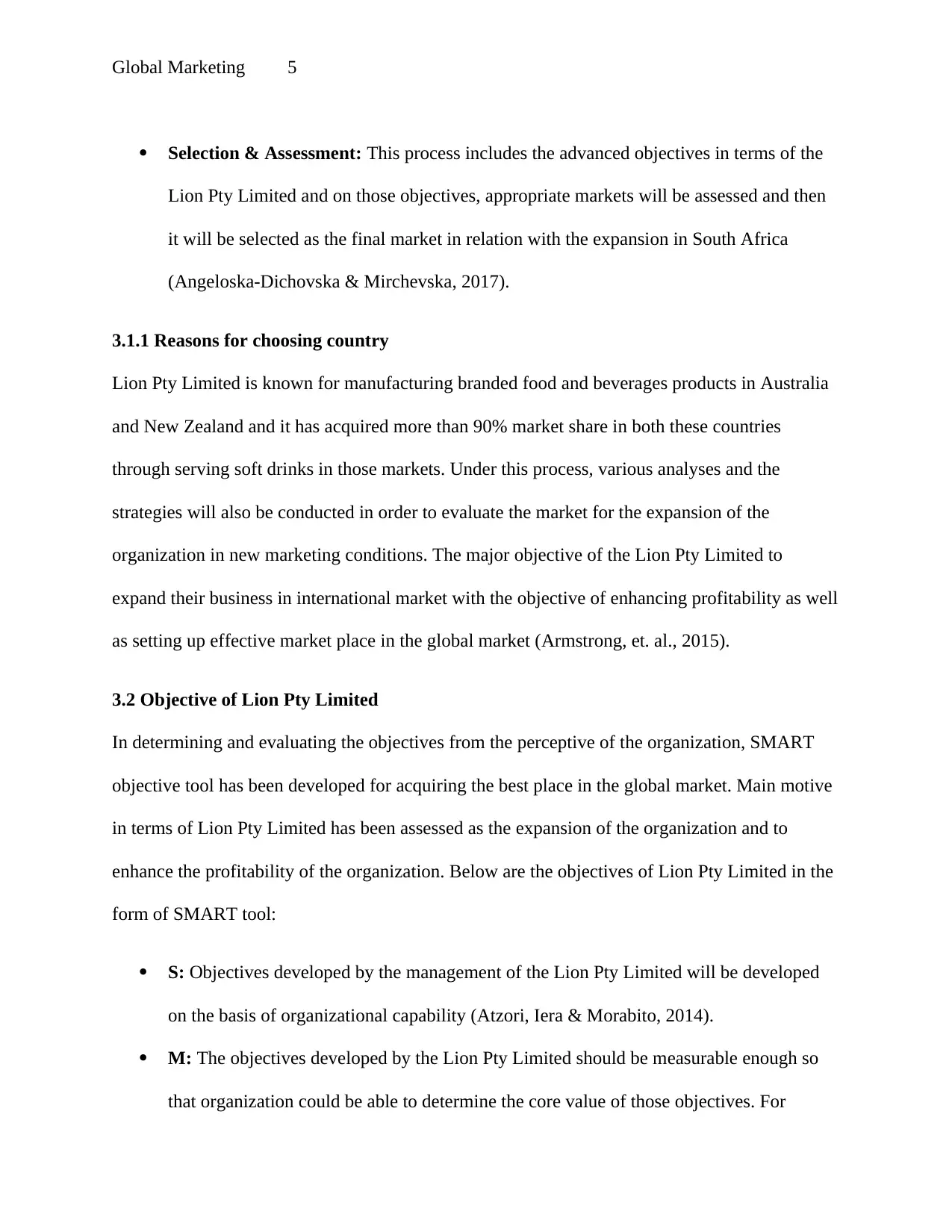
Global Marketing 5
Selection & Assessment: This process includes the advanced objectives in terms of the
Lion Pty Limited and on those objectives, appropriate markets will be assessed and then
it will be selected as the final market in relation with the expansion in South Africa
(Angeloska-Dichovska & Mirchevska, 2017).
3.1.1 Reasons for choosing country
Lion Pty Limited is known for manufacturing branded food and beverages products in Australia
and New Zealand and it has acquired more than 90% market share in both these countries
through serving soft drinks in those markets. Under this process, various analyses and the
strategies will also be conducted in order to evaluate the market for the expansion of the
organization in new marketing conditions. The major objective of the Lion Pty Limited to
expand their business in international market with the objective of enhancing profitability as well
as setting up effective market place in the global market (Armstrong, et. al., 2015).
3.2 Objective of Lion Pty Limited
In determining and evaluating the objectives from the perceptive of the organization, SMART
objective tool has been developed for acquiring the best place in the global market. Main motive
in terms of Lion Pty Limited has been assessed as the expansion of the organization and to
enhance the profitability of the organization. Below are the objectives of Lion Pty Limited in the
form of SMART tool:
S: Objectives developed by the management of the Lion Pty Limited will be developed
on the basis of organizational capability (Atzori, Iera & Morabito, 2014).
M: The objectives developed by the Lion Pty Limited should be measurable enough so
that organization could be able to determine the core value of those objectives. For
Selection & Assessment: This process includes the advanced objectives in terms of the
Lion Pty Limited and on those objectives, appropriate markets will be assessed and then
it will be selected as the final market in relation with the expansion in South Africa
(Angeloska-Dichovska & Mirchevska, 2017).
3.1.1 Reasons for choosing country
Lion Pty Limited is known for manufacturing branded food and beverages products in Australia
and New Zealand and it has acquired more than 90% market share in both these countries
through serving soft drinks in those markets. Under this process, various analyses and the
strategies will also be conducted in order to evaluate the market for the expansion of the
organization in new marketing conditions. The major objective of the Lion Pty Limited to
expand their business in international market with the objective of enhancing profitability as well
as setting up effective market place in the global market (Armstrong, et. al., 2015).
3.2 Objective of Lion Pty Limited
In determining and evaluating the objectives from the perceptive of the organization, SMART
objective tool has been developed for acquiring the best place in the global market. Main motive
in terms of Lion Pty Limited has been assessed as the expansion of the organization and to
enhance the profitability of the organization. Below are the objectives of Lion Pty Limited in the
form of SMART tool:
S: Objectives developed by the management of the Lion Pty Limited will be developed
on the basis of organizational capability (Atzori, Iera & Morabito, 2014).
M: The objectives developed by the Lion Pty Limited should be measurable enough so
that organization could be able to determine the core value of those objectives. For
⊘ This is a preview!⊘
Do you want full access?
Subscribe today to unlock all pages.

Trusted by 1+ million students worldwide
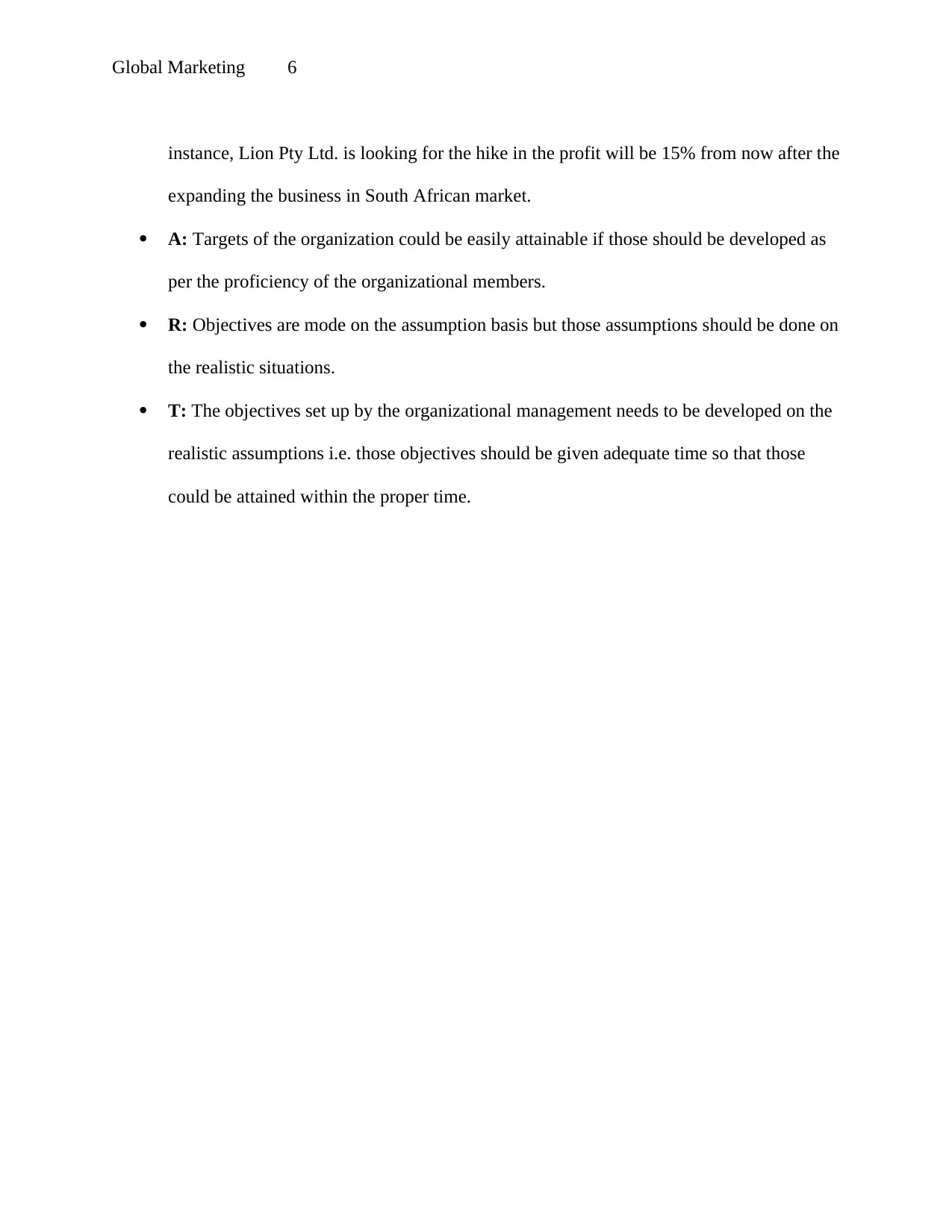
Global Marketing 6
instance, Lion Pty Ltd. is looking for the hike in the profit will be 15% from now after the
expanding the business in South African market.
A: Targets of the organization could be easily attainable if those should be developed as
per the proficiency of the organizational members.
R: Objectives are mode on the assumption basis but those assumptions should be done on
the realistic situations.
T: The objectives set up by the organizational management needs to be developed on the
realistic assumptions i.e. those objectives should be given adequate time so that those
could be attained within the proper time.
instance, Lion Pty Ltd. is looking for the hike in the profit will be 15% from now after the
expanding the business in South African market.
A: Targets of the organization could be easily attainable if those should be developed as
per the proficiency of the organizational members.
R: Objectives are mode on the assumption basis but those assumptions should be done on
the realistic situations.
T: The objectives set up by the organizational management needs to be developed on the
realistic assumptions i.e. those objectives should be given adequate time so that those
could be attained within the proper time.
Paraphrase This Document
Need a fresh take? Get an instant paraphrase of this document with our AI Paraphraser
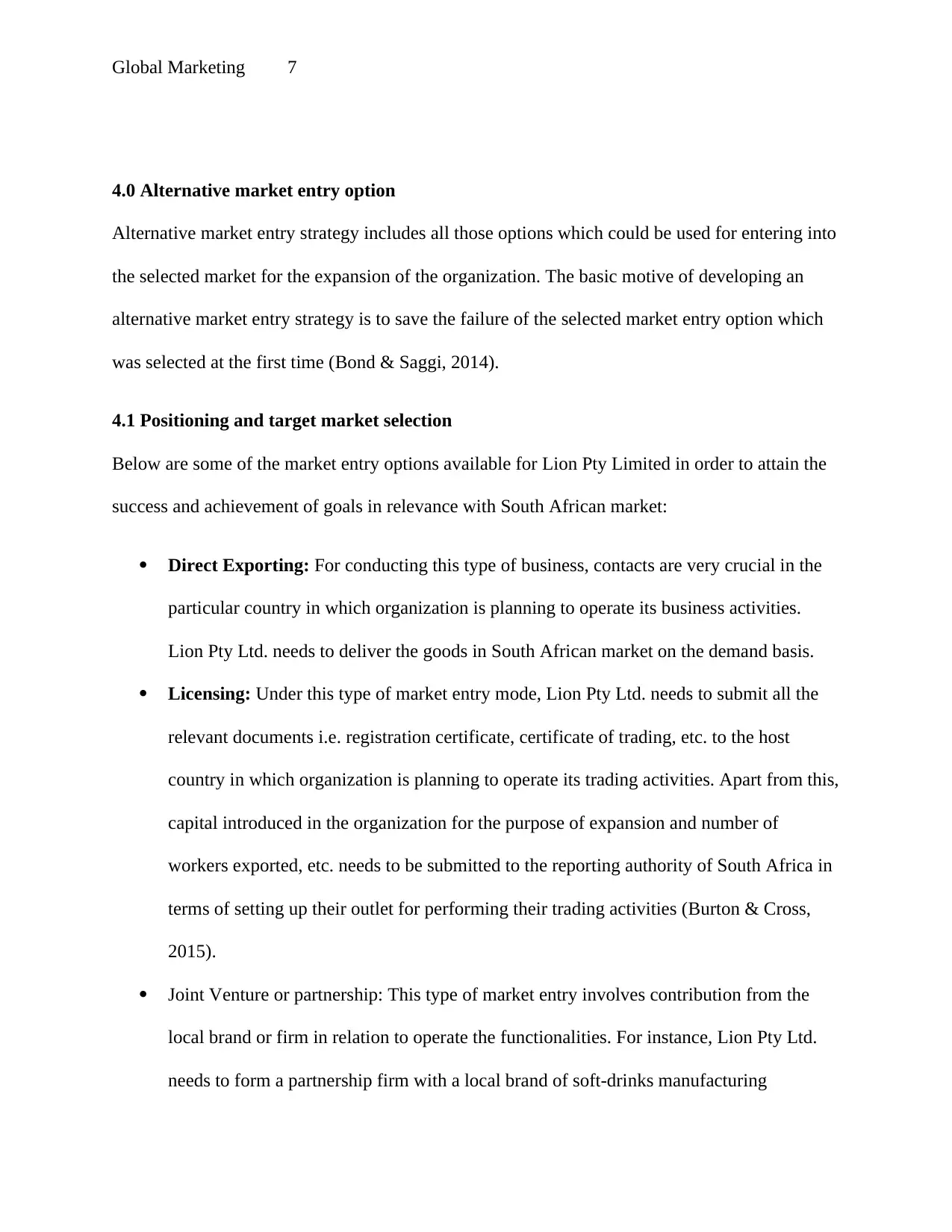
Global Marketing 7
4.0 Alternative market entry option
Alternative market entry strategy includes all those options which could be used for entering into
the selected market for the expansion of the organization. The basic motive of developing an
alternative market entry strategy is to save the failure of the selected market entry option which
was selected at the first time (Bond & Saggi, 2014).
4.1 Positioning and target market selection
Below are some of the market entry options available for Lion Pty Limited in order to attain the
success and achievement of goals in relevance with South African market:
Direct Exporting: For conducting this type of business, contacts are very crucial in the
particular country in which organization is planning to operate its business activities.
Lion Pty Ltd. needs to deliver the goods in South African market on the demand basis.
Licensing: Under this type of market entry mode, Lion Pty Ltd. needs to submit all the
relevant documents i.e. registration certificate, certificate of trading, etc. to the host
country in which organization is planning to operate its trading activities. Apart from this,
capital introduced in the organization for the purpose of expansion and number of
workers exported, etc. needs to be submitted to the reporting authority of South Africa in
terms of setting up their outlet for performing their trading activities (Burton & Cross,
2015).
Joint Venture or partnership: This type of market entry involves contribution from the
local brand or firm in relation to operate the functionalities. For instance, Lion Pty Ltd.
needs to form a partnership firm with a local brand of soft-drinks manufacturing
4.0 Alternative market entry option
Alternative market entry strategy includes all those options which could be used for entering into
the selected market for the expansion of the organization. The basic motive of developing an
alternative market entry strategy is to save the failure of the selected market entry option which
was selected at the first time (Bond & Saggi, 2014).
4.1 Positioning and target market selection
Below are some of the market entry options available for Lion Pty Limited in order to attain the
success and achievement of goals in relevance with South African market:
Direct Exporting: For conducting this type of business, contacts are very crucial in the
particular country in which organization is planning to operate its business activities.
Lion Pty Ltd. needs to deliver the goods in South African market on the demand basis.
Licensing: Under this type of market entry mode, Lion Pty Ltd. needs to submit all the
relevant documents i.e. registration certificate, certificate of trading, etc. to the host
country in which organization is planning to operate its trading activities. Apart from this,
capital introduced in the organization for the purpose of expansion and number of
workers exported, etc. needs to be submitted to the reporting authority of South Africa in
terms of setting up their outlet for performing their trading activities (Burton & Cross,
2015).
Joint Venture or partnership: This type of market entry involves contribution from the
local brand or firm in relation to operate the functionalities. For instance, Lion Pty Ltd.
needs to form a partnership firm with a local brand of soft-drinks manufacturing
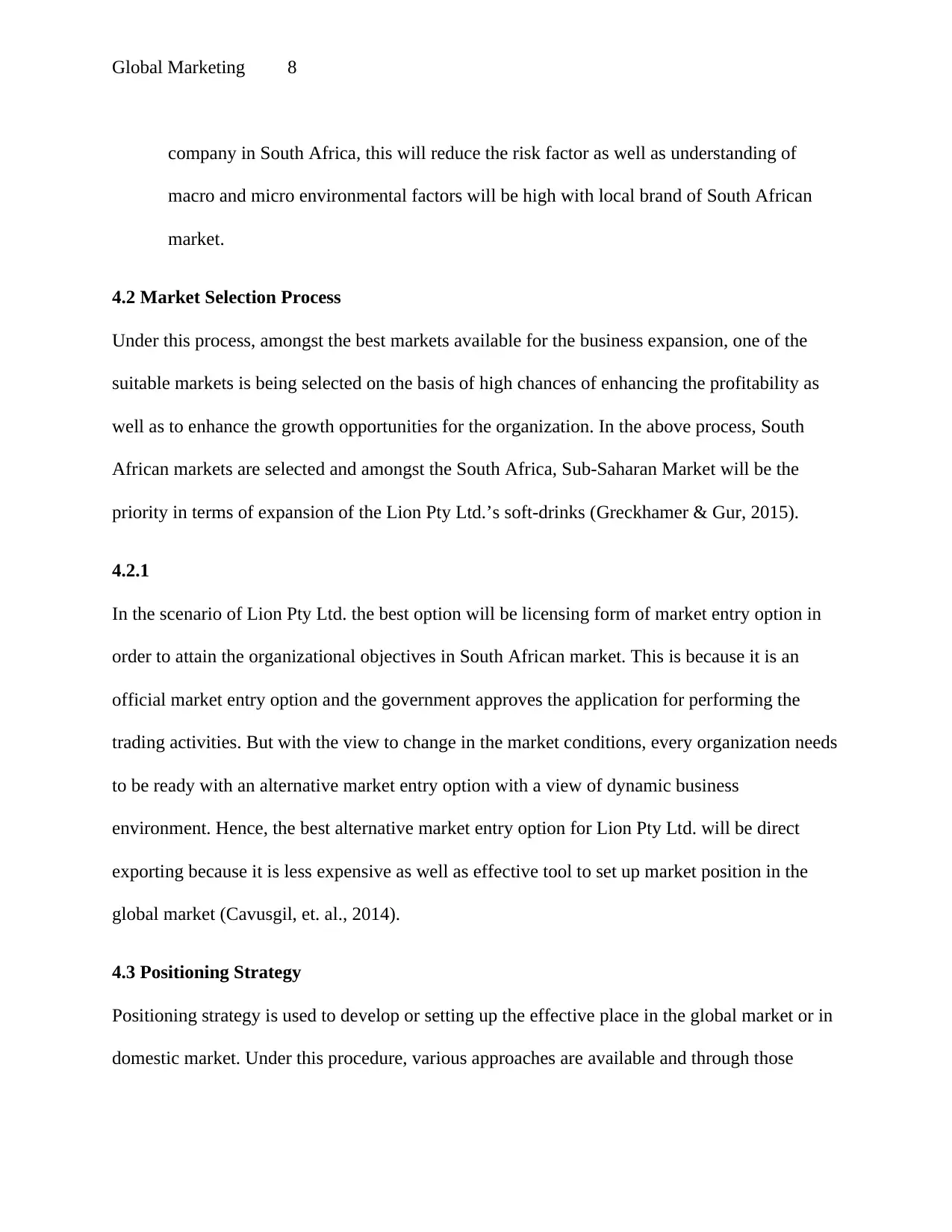
Global Marketing 8
company in South Africa, this will reduce the risk factor as well as understanding of
macro and micro environmental factors will be high with local brand of South African
market.
4.2 Market Selection Process
Under this process, amongst the best markets available for the business expansion, one of the
suitable markets is being selected on the basis of high chances of enhancing the profitability as
well as to enhance the growth opportunities for the organization. In the above process, South
African markets are selected and amongst the South Africa, Sub-Saharan Market will be the
priority in terms of expansion of the Lion Pty Ltd.’s soft-drinks (Greckhamer & Gur, 2015).
4.2.1
In the scenario of Lion Pty Ltd. the best option will be licensing form of market entry option in
order to attain the organizational objectives in South African market. This is because it is an
official market entry option and the government approves the application for performing the
trading activities. But with the view to change in the market conditions, every organization needs
to be ready with an alternative market entry option with a view of dynamic business
environment. Hence, the best alternative market entry option for Lion Pty Ltd. will be direct
exporting because it is less expensive as well as effective tool to set up market position in the
global market (Cavusgil, et. al., 2014).
4.3 Positioning Strategy
Positioning strategy is used to develop or setting up the effective place in the global market or in
domestic market. Under this procedure, various approaches are available and through those
company in South Africa, this will reduce the risk factor as well as understanding of
macro and micro environmental factors will be high with local brand of South African
market.
4.2 Market Selection Process
Under this process, amongst the best markets available for the business expansion, one of the
suitable markets is being selected on the basis of high chances of enhancing the profitability as
well as to enhance the growth opportunities for the organization. In the above process, South
African markets are selected and amongst the South Africa, Sub-Saharan Market will be the
priority in terms of expansion of the Lion Pty Ltd.’s soft-drinks (Greckhamer & Gur, 2015).
4.2.1
In the scenario of Lion Pty Ltd. the best option will be licensing form of market entry option in
order to attain the organizational objectives in South African market. This is because it is an
official market entry option and the government approves the application for performing the
trading activities. But with the view to change in the market conditions, every organization needs
to be ready with an alternative market entry option with a view of dynamic business
environment. Hence, the best alternative market entry option for Lion Pty Ltd. will be direct
exporting because it is less expensive as well as effective tool to set up market position in the
global market (Cavusgil, et. al., 2014).
4.3 Positioning Strategy
Positioning strategy is used to develop or setting up the effective place in the global market or in
domestic market. Under this procedure, various approaches are available and through those
⊘ This is a preview!⊘
Do you want full access?
Subscribe today to unlock all pages.

Trusted by 1+ million students worldwide
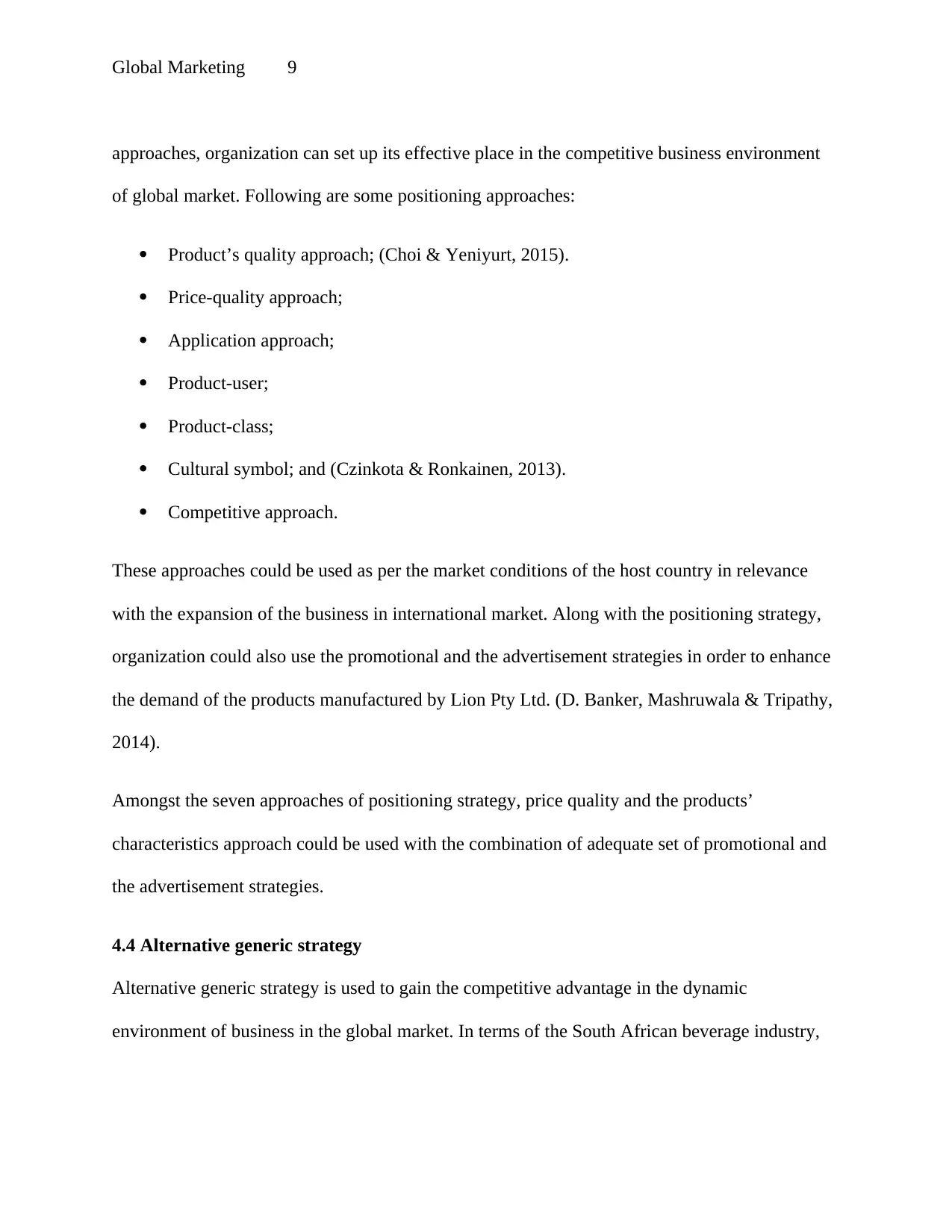
Global Marketing 9
approaches, organization can set up its effective place in the competitive business environment
of global market. Following are some positioning approaches:
Product’s quality approach; (Choi & Yeniyurt, 2015).
Price-quality approach;
Application approach;
Product-user;
Product-class;
Cultural symbol; and (Czinkota & Ronkainen, 2013).
Competitive approach.
These approaches could be used as per the market conditions of the host country in relevance
with the expansion of the business in international market. Along with the positioning strategy,
organization could also use the promotional and the advertisement strategies in order to enhance
the demand of the products manufactured by Lion Pty Ltd. (D. Banker, Mashruwala & Tripathy,
2014).
Amongst the seven approaches of positioning strategy, price quality and the products’
characteristics approach could be used with the combination of adequate set of promotional and
the advertisement strategies.
4.4 Alternative generic strategy
Alternative generic strategy is used to gain the competitive advantage in the dynamic
environment of business in the global market. In terms of the South African beverage industry,
approaches, organization can set up its effective place in the competitive business environment
of global market. Following are some positioning approaches:
Product’s quality approach; (Choi & Yeniyurt, 2015).
Price-quality approach;
Application approach;
Product-user;
Product-class;
Cultural symbol; and (Czinkota & Ronkainen, 2013).
Competitive approach.
These approaches could be used as per the market conditions of the host country in relevance
with the expansion of the business in international market. Along with the positioning strategy,
organization could also use the promotional and the advertisement strategies in order to enhance
the demand of the products manufactured by Lion Pty Ltd. (D. Banker, Mashruwala & Tripathy,
2014).
Amongst the seven approaches of positioning strategy, price quality and the products’
characteristics approach could be used with the combination of adequate set of promotional and
the advertisement strategies.
4.4 Alternative generic strategy
Alternative generic strategy is used to gain the competitive advantage in the dynamic
environment of business in the global market. In terms of the South African beverage industry,
Paraphrase This Document
Need a fresh take? Get an instant paraphrase of this document with our AI Paraphraser
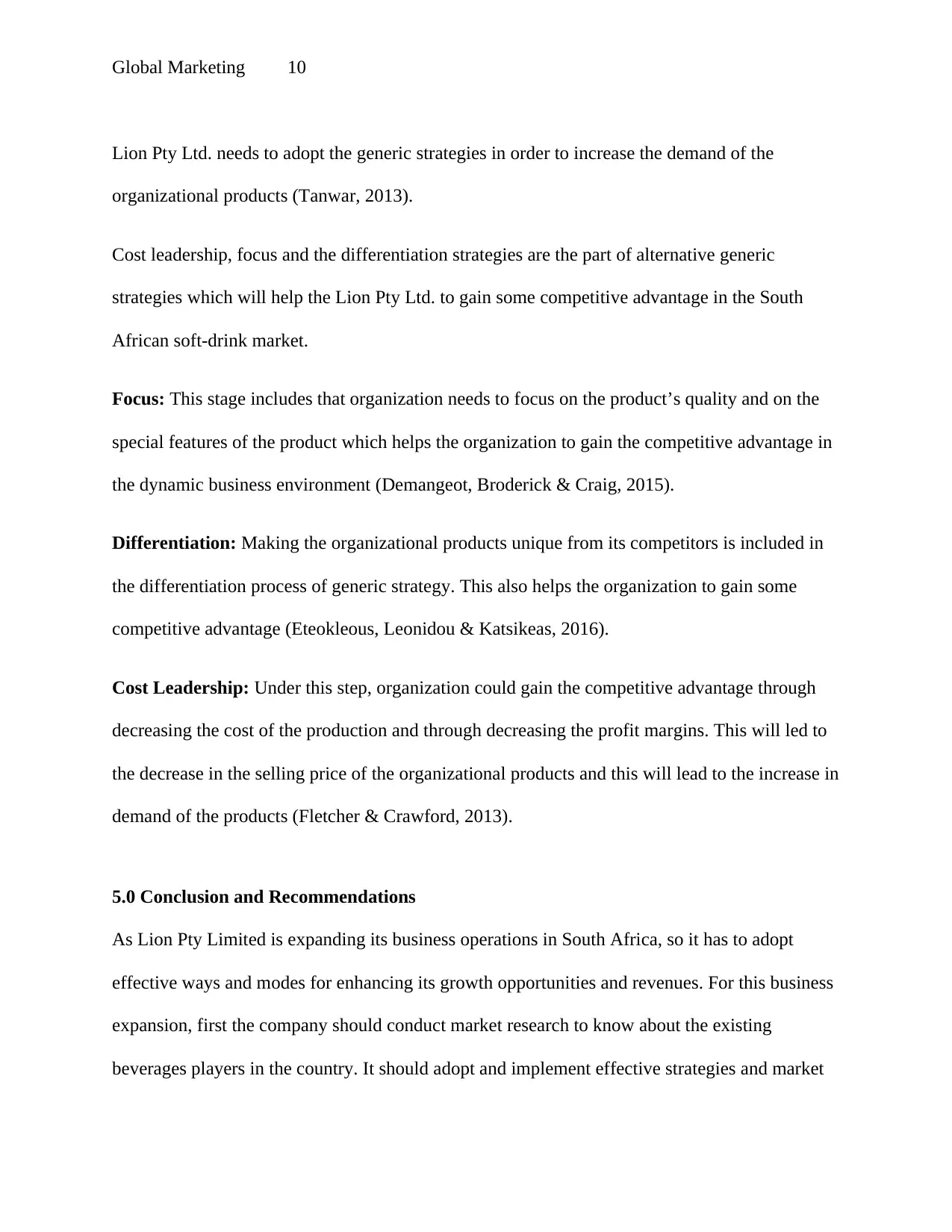
Global Marketing 10
Lion Pty Ltd. needs to adopt the generic strategies in order to increase the demand of the
organizational products (Tanwar, 2013).
Cost leadership, focus and the differentiation strategies are the part of alternative generic
strategies which will help the Lion Pty Ltd. to gain some competitive advantage in the South
African soft-drink market.
Focus: This stage includes that organization needs to focus on the product’s quality and on the
special features of the product which helps the organization to gain the competitive advantage in
the dynamic business environment (Demangeot, Broderick & Craig, 2015).
Differentiation: Making the organizational products unique from its competitors is included in
the differentiation process of generic strategy. This also helps the organization to gain some
competitive advantage (Eteokleous, Leonidou & Katsikeas, 2016).
Cost Leadership: Under this step, organization could gain the competitive advantage through
decreasing the cost of the production and through decreasing the profit margins. This will led to
the decrease in the selling price of the organizational products and this will lead to the increase in
demand of the products (Fletcher & Crawford, 2013).
5.0 Conclusion and Recommendations
As Lion Pty Limited is expanding its business operations in South Africa, so it has to adopt
effective ways and modes for enhancing its growth opportunities and revenues. For this business
expansion, first the company should conduct market research to know about the existing
beverages players in the country. It should adopt and implement effective strategies and market
Lion Pty Ltd. needs to adopt the generic strategies in order to increase the demand of the
organizational products (Tanwar, 2013).
Cost leadership, focus and the differentiation strategies are the part of alternative generic
strategies which will help the Lion Pty Ltd. to gain some competitive advantage in the South
African soft-drink market.
Focus: This stage includes that organization needs to focus on the product’s quality and on the
special features of the product which helps the organization to gain the competitive advantage in
the dynamic business environment (Demangeot, Broderick & Craig, 2015).
Differentiation: Making the organizational products unique from its competitors is included in
the differentiation process of generic strategy. This also helps the organization to gain some
competitive advantage (Eteokleous, Leonidou & Katsikeas, 2016).
Cost Leadership: Under this step, organization could gain the competitive advantage through
decreasing the cost of the production and through decreasing the profit margins. This will led to
the decrease in the selling price of the organizational products and this will lead to the increase in
demand of the products (Fletcher & Crawford, 2013).
5.0 Conclusion and Recommendations
As Lion Pty Limited is expanding its business operations in South Africa, so it has to adopt
effective ways and modes for enhancing its growth opportunities and revenues. For this business
expansion, first the company should conduct market research to know about the existing
beverages players in the country. It should adopt and implement effective strategies and market
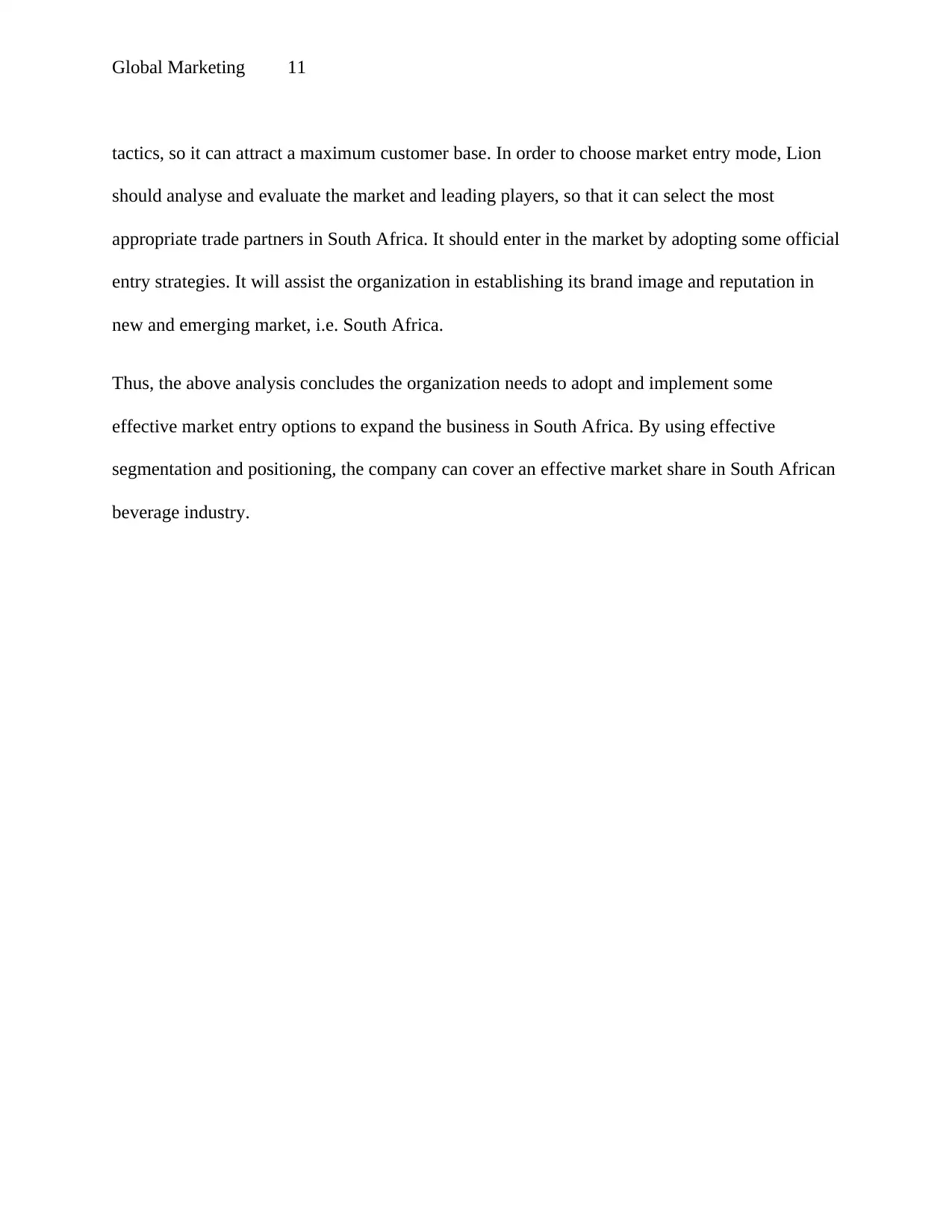
Global Marketing 11
tactics, so it can attract a maximum customer base. In order to choose market entry mode, Lion
should analyse and evaluate the market and leading players, so that it can select the most
appropriate trade partners in South Africa. It should enter in the market by adopting some official
entry strategies. It will assist the organization in establishing its brand image and reputation in
new and emerging market, i.e. South Africa.
Thus, the above analysis concludes the organization needs to adopt and implement some
effective market entry options to expand the business in South Africa. By using effective
segmentation and positioning, the company can cover an effective market share in South African
beverage industry.
tactics, so it can attract a maximum customer base. In order to choose market entry mode, Lion
should analyse and evaluate the market and leading players, so that it can select the most
appropriate trade partners in South Africa. It should enter in the market by adopting some official
entry strategies. It will assist the organization in establishing its brand image and reputation in
new and emerging market, i.e. South Africa.
Thus, the above analysis concludes the organization needs to adopt and implement some
effective market entry options to expand the business in South Africa. By using effective
segmentation and positioning, the company can cover an effective market share in South African
beverage industry.
⊘ This is a preview!⊘
Do you want full access?
Subscribe today to unlock all pages.

Trusted by 1+ million students worldwide
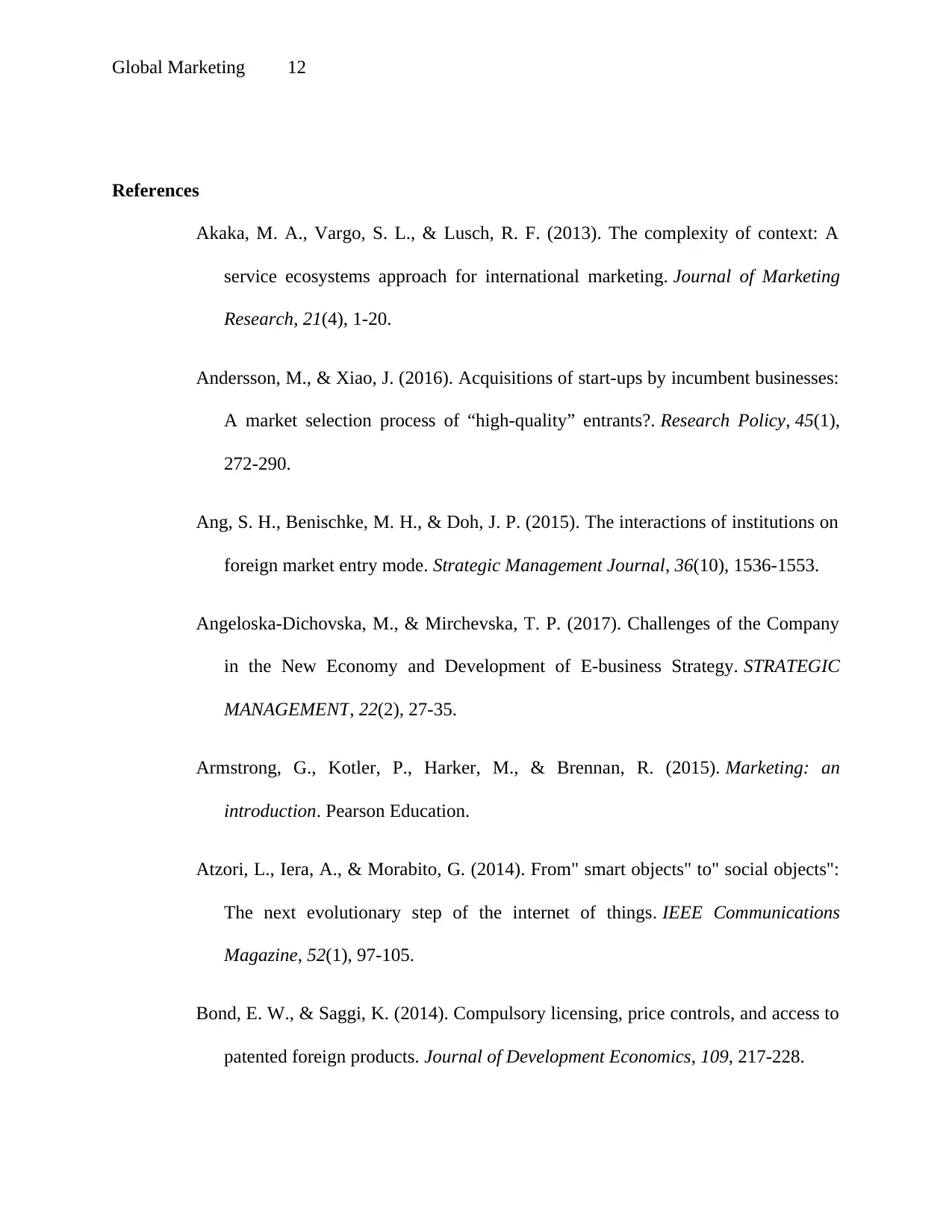
Global Marketing 12
References
Akaka, M. A., Vargo, S. L., & Lusch, R. F. (2013). The complexity of context: A
service ecosystems approach for international marketing. Journal of Marketing
Research, 21(4), 1-20.
Andersson, M., & Xiao, J. (2016). Acquisitions of start-ups by incumbent businesses:
A market selection process of “high-quality” entrants?. Research Policy, 45(1),
272-290.
Ang, S. H., Benischke, M. H., & Doh, J. P. (2015). The interactions of institutions on
foreign market entry mode. Strategic Management Journal, 36(10), 1536-1553.
Angeloska-Dichovska, M., & Mirchevska, T. P. (2017). Challenges of the Company
in the New Economy and Development of E-business Strategy. STRATEGIC
MANAGEMENT, 22(2), 27-35.
Armstrong, G., Kotler, P., Harker, M., & Brennan, R. (2015). Marketing: an
introduction. Pearson Education.
Atzori, L., Iera, A., & Morabito, G. (2014). From" smart objects" to" social objects":
The next evolutionary step of the internet of things. IEEE Communications
Magazine, 52(1), 97-105.
Bond, E. W., & Saggi, K. (2014). Compulsory licensing, price controls, and access to
patented foreign products. Journal of Development Economics, 109, 217-228.
References
Akaka, M. A., Vargo, S. L., & Lusch, R. F. (2013). The complexity of context: A
service ecosystems approach for international marketing. Journal of Marketing
Research, 21(4), 1-20.
Andersson, M., & Xiao, J. (2016). Acquisitions of start-ups by incumbent businesses:
A market selection process of “high-quality” entrants?. Research Policy, 45(1),
272-290.
Ang, S. H., Benischke, M. H., & Doh, J. P. (2015). The interactions of institutions on
foreign market entry mode. Strategic Management Journal, 36(10), 1536-1553.
Angeloska-Dichovska, M., & Mirchevska, T. P. (2017). Challenges of the Company
in the New Economy and Development of E-business Strategy. STRATEGIC
MANAGEMENT, 22(2), 27-35.
Armstrong, G., Kotler, P., Harker, M., & Brennan, R. (2015). Marketing: an
introduction. Pearson Education.
Atzori, L., Iera, A., & Morabito, G. (2014). From" smart objects" to" social objects":
The next evolutionary step of the internet of things. IEEE Communications
Magazine, 52(1), 97-105.
Bond, E. W., & Saggi, K. (2014). Compulsory licensing, price controls, and access to
patented foreign products. Journal of Development Economics, 109, 217-228.
Paraphrase This Document
Need a fresh take? Get an instant paraphrase of this document with our AI Paraphraser
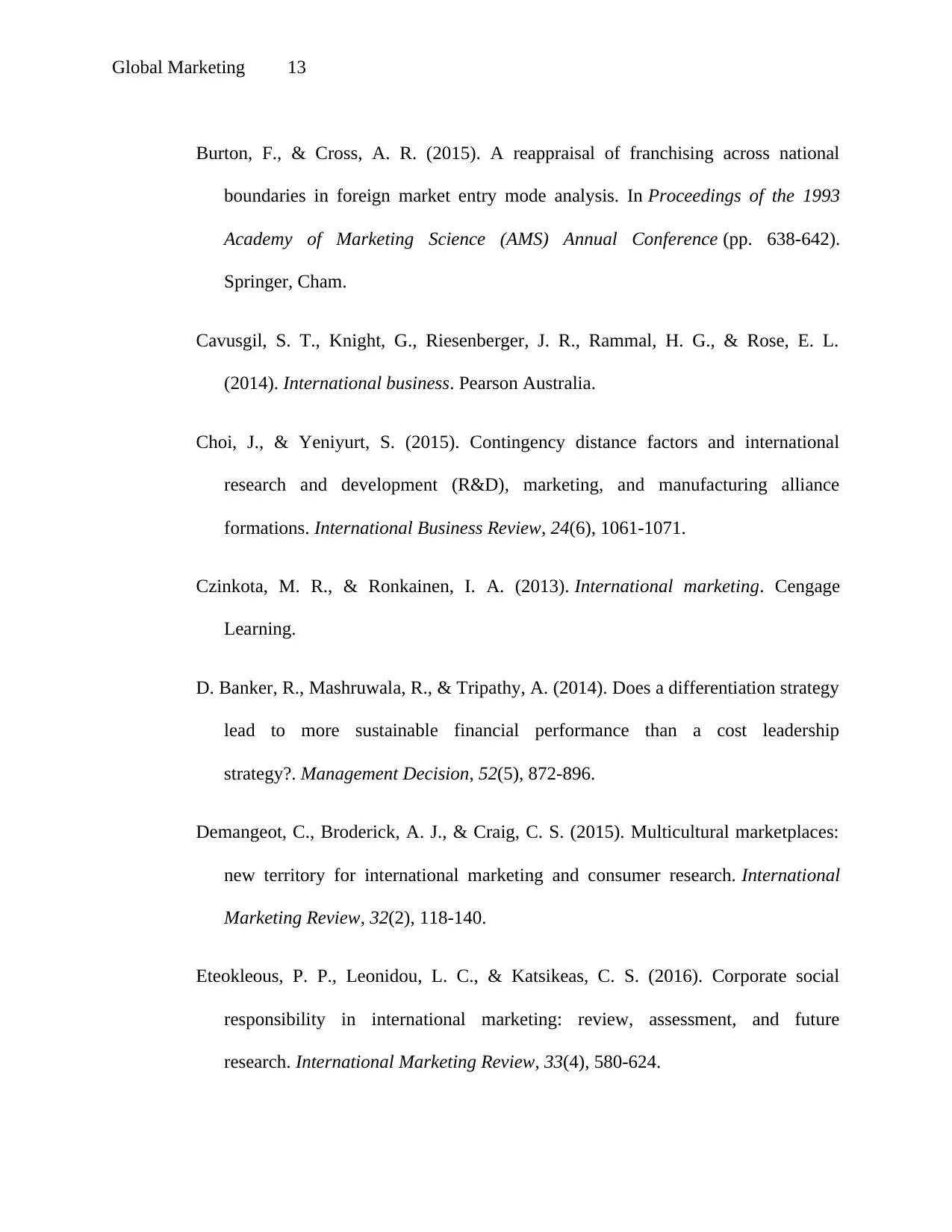
Global Marketing 13
Burton, F., & Cross, A. R. (2015). A reappraisal of franchising across national
boundaries in foreign market entry mode analysis. In Proceedings of the 1993
Academy of Marketing Science (AMS) Annual Conference (pp. 638-642).
Springer, Cham.
Cavusgil, S. T., Knight, G., Riesenberger, J. R., Rammal, H. G., & Rose, E. L.
(2014). International business. Pearson Australia.
Choi, J., & Yeniyurt, S. (2015). Contingency distance factors and international
research and development (R&D), marketing, and manufacturing alliance
formations. International Business Review, 24(6), 1061-1071.
Czinkota, M. R., & Ronkainen, I. A. (2013). International marketing. Cengage
Learning.
D. Banker, R., Mashruwala, R., & Tripathy, A. (2014). Does a differentiation strategy
lead to more sustainable financial performance than a cost leadership
strategy?. Management Decision, 52(5), 872-896.
Demangeot, C., Broderick, A. J., & Craig, C. S. (2015). Multicultural marketplaces:
new territory for international marketing and consumer research. International
Marketing Review, 32(2), 118-140.
Eteokleous, P. P., Leonidou, L. C., & Katsikeas, C. S. (2016). Corporate social
responsibility in international marketing: review, assessment, and future
research. International Marketing Review, 33(4), 580-624.
Burton, F., & Cross, A. R. (2015). A reappraisal of franchising across national
boundaries in foreign market entry mode analysis. In Proceedings of the 1993
Academy of Marketing Science (AMS) Annual Conference (pp. 638-642).
Springer, Cham.
Cavusgil, S. T., Knight, G., Riesenberger, J. R., Rammal, H. G., & Rose, E. L.
(2014). International business. Pearson Australia.
Choi, J., & Yeniyurt, S. (2015). Contingency distance factors and international
research and development (R&D), marketing, and manufacturing alliance
formations. International Business Review, 24(6), 1061-1071.
Czinkota, M. R., & Ronkainen, I. A. (2013). International marketing. Cengage
Learning.
D. Banker, R., Mashruwala, R., & Tripathy, A. (2014). Does a differentiation strategy
lead to more sustainable financial performance than a cost leadership
strategy?. Management Decision, 52(5), 872-896.
Demangeot, C., Broderick, A. J., & Craig, C. S. (2015). Multicultural marketplaces:
new territory for international marketing and consumer research. International
Marketing Review, 32(2), 118-140.
Eteokleous, P. P., Leonidou, L. C., & Katsikeas, C. S. (2016). Corporate social
responsibility in international marketing: review, assessment, and future
research. International Marketing Review, 33(4), 580-624.
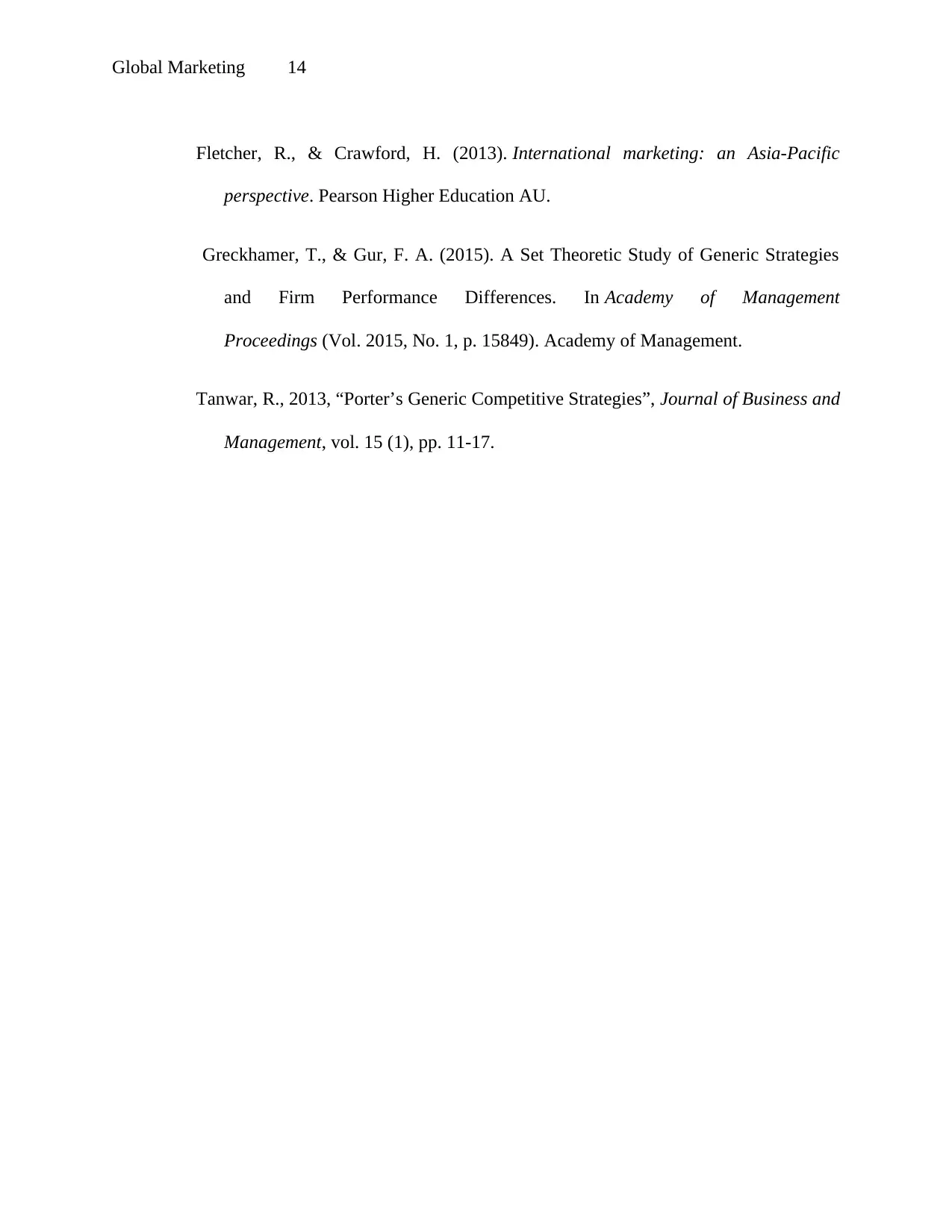
Global Marketing 14
Fletcher, R., & Crawford, H. (2013). International marketing: an Asia-Pacific
perspective. Pearson Higher Education AU.
Greckhamer, T., & Gur, F. A. (2015). A Set Theoretic Study of Generic Strategies
and Firm Performance Differences. In Academy of Management
Proceedings (Vol. 2015, No. 1, p. 15849). Academy of Management.
Tanwar, R., 2013, “Porter’s Generic Competitive Strategies”, Journal of Business and
Management, vol. 15 (1), pp. 11-17.
Fletcher, R., & Crawford, H. (2013). International marketing: an Asia-Pacific
perspective. Pearson Higher Education AU.
Greckhamer, T., & Gur, F. A. (2015). A Set Theoretic Study of Generic Strategies
and Firm Performance Differences. In Academy of Management
Proceedings (Vol. 2015, No. 1, p. 15849). Academy of Management.
Tanwar, R., 2013, “Porter’s Generic Competitive Strategies”, Journal of Business and
Management, vol. 15 (1), pp. 11-17.
⊘ This is a preview!⊘
Do you want full access?
Subscribe today to unlock all pages.

Trusted by 1+ million students worldwide
1 out of 15
Related Documents
Your All-in-One AI-Powered Toolkit for Academic Success.
+13062052269
info@desklib.com
Available 24*7 on WhatsApp / Email
![[object Object]](/_next/static/media/star-bottom.7253800d.svg)
Unlock your academic potential
© 2024 | Zucol Services PVT LTD | All rights reserved.





